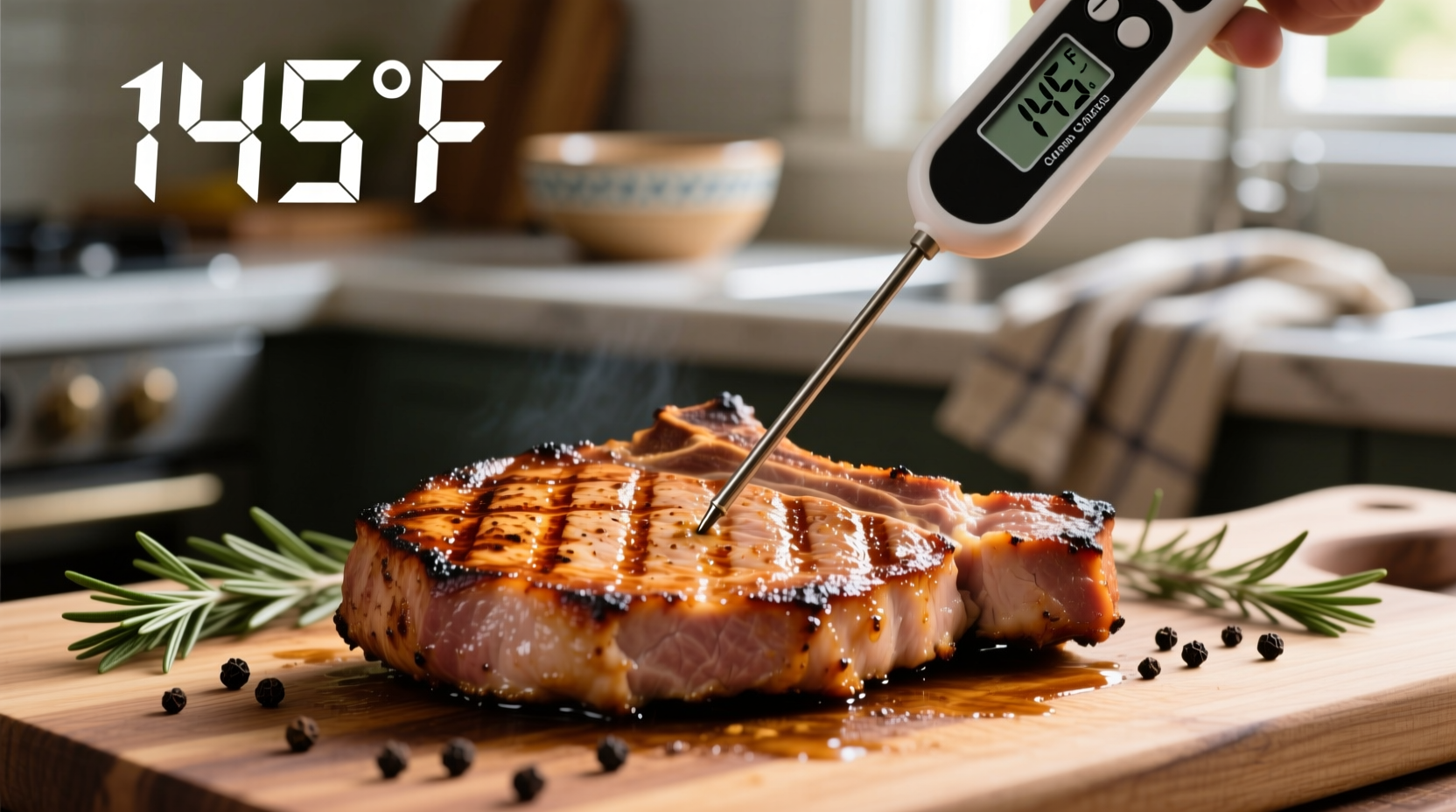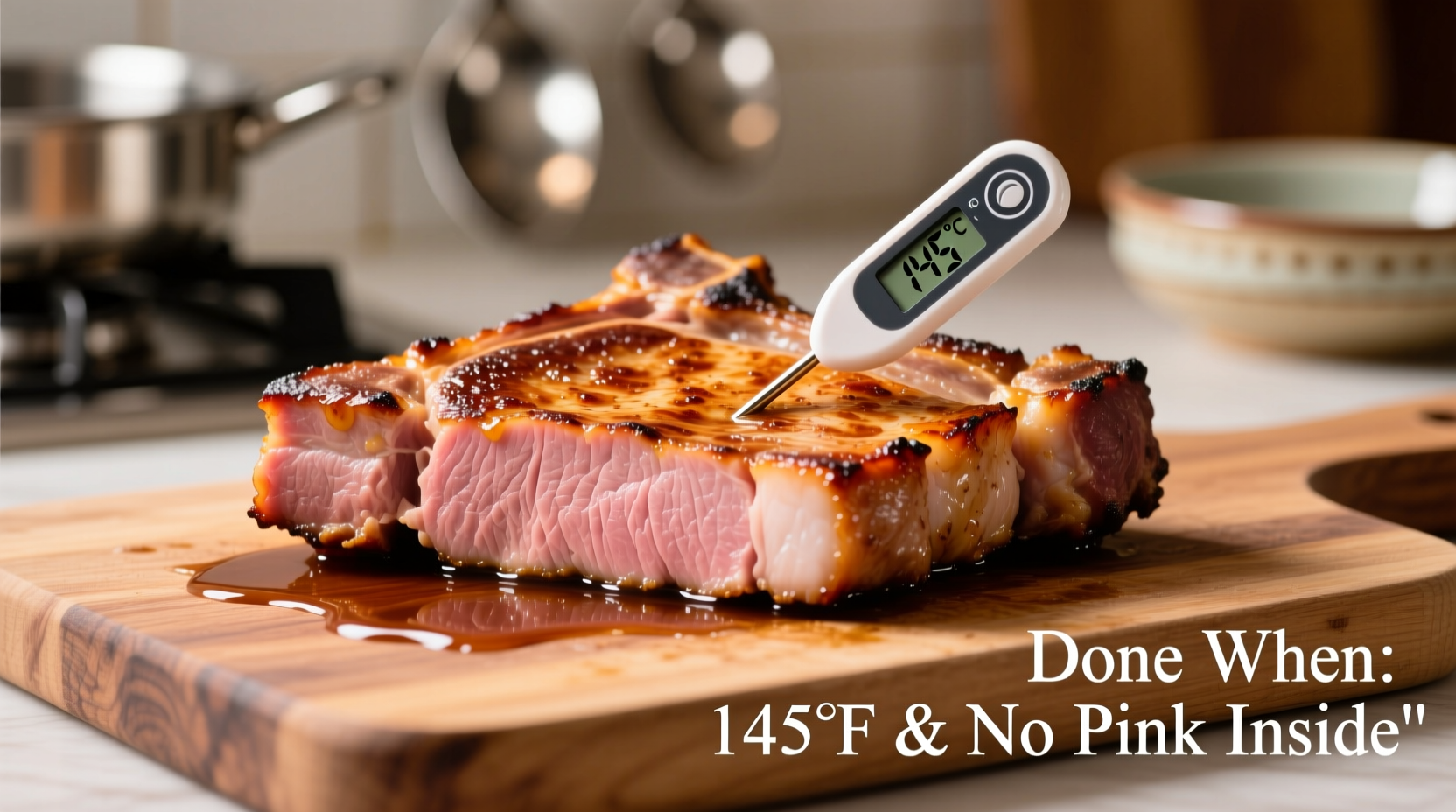For years, home cooks were told to cook pork until it was well done with no trace of pink. But modern farming practices and food safety standards have evolved, allowing us to enjoy pork chops that are perfectly cooked through yet still juicy and flavorful. Getting this right matters for both food safety and eating pleasure.
Why Proper Pork Chop Doneness Matters
Understanding when pork chops are done isn't just about following rules—it directly impacts your meal's safety and quality. Undercooked pork can pose health risks, while overcooked pork becomes dry and tough. The sweet spot delivers both safety and exceptional eating experience.
The Thermometer Method: Most Reliable Indicator
Professional chefs and food safety experts agree: a digital meat thermometer provides the most accurate determination of pork chop doneness. Here's how to use it properly:
- Insert the thermometer into the thickest part of the chop, avoiding bone or fat
- Wait 10-15 seconds for an accurate reading
- Remove chops from heat at 140-142°F to account for temperature rise during resting
- Allow 3 minutes of resting time before serving
The USDA's Food Safety and Inspection Service confirms that 145°F with 3-minute rest is safe for pork, eliminating previous concerns about trichinosis in commercially raised pork.

Visual Indicators of Properly Cooked Pork Chops
While a thermometer is best, visual cues provide helpful secondary confirmation:
| Temperature | Color Appearance | Texture | Doneness Level |
|---|---|---|---|
| 130-135°F | Bright pink center | Very soft, squishy | Undercooked |
| 140-145°F | Light pink center | Firm but yielding | Perfectly cooked |
| 150-155°F | Slight pink tinge | Firm | Slightly overcooked |
| 160°F+ | No pink, grayish-white | Very firm, dry | Overcooked |
Look for clear or faintly pink juices rather than bright red. As pork reaches proper doneness, the juices transition from red to a lighter, more translucent appearance.
The Touch Test: Professional Chef Technique
Chefs often use the touch test to estimate doneness without cutting into meat. Compare the firmness of your pork chop to different parts of your hand:
- Rare: Similar to the fleshy area below your thumb when hand is relaxed (very soft)
- Medium: Like your palm when touching thumb to index finger (slightly springy)
- Well-done: Resembles palm when touching thumb to pinky (very firm)
For perfectly cooked pork chops (145°F), aim for the firmness between medium and well-done—yielding slightly when pressed but not mushy. This method requires practice but becomes intuitive with experience.
Common Mistakes That Lead to Disappointing Results
Avoid these frequent errors that compromise your pork chop experience:
- Skipping the rest period: Cutting immediately after cooking releases precious juices
- Overcrowding the pan: Causes steaming instead of searing, leading to uneven cooking
- Relying solely on color: Some pork varieties naturally have darker color even when properly cooked
- Not accounting for carryover cooking: Temperature continues rising 5-10°F after removal from heat
The Agricultural Marketing Service notes that modern pork is significantly leaner than in previous decades, making precise temperature control even more critical to prevent dryness.
Cooking Method Variations
Regardless of whether you're pan-searing, grilling, or baking, the target temperature remains the same. However, different methods require slight technique adjustments:
- Pan-searing: Cook 3-4 minutes per side then finish in oven if thick
- Grilling: Use two-zone fire to sear then move to indirect heat
- Baking: Start at high heat (400°F) then reduce to 350°F for even cooking
Thinner chops (under ¼ inch) cook extremely quickly and benefit from a lower cooking temperature to prevent overcooking before proper sear develops.
Troubleshooting Doneness Issues
Even experienced cooks occasionally face doneness challenges. Here's how to handle common situations:
- Undercooked: Return to heat for 1-2 minutes per side, checking thermometer frequently
- Overcooked: Slice thinly against the grain and serve with sauce or gravy
- Inconsistent thickness: Butterfly thicker portions or use the "tenting" technique with foil
Remember that bone-in chops take slightly longer to cook than boneless, and marbled chops may appear done at lower temperatures than very lean cuts.
Why Resting Time Matters: The Science
The USDA's 3-minute rest period isn't arbitrary. During this time:
- Temperature evens out throughout the chop
- Proteins relax, retaining more moisture
- Carryover cooking completes the process
- Juices redistribute for more uniform texture
Skipping this critical step often results in dry pork, even if you removed it from heat at the perfect temperature. Cover loosely with foil to retain heat without steaming the crust.
FAQs About Pork Chop Doneness
Can pork chops be pink and still be safe to eat?
Yes, pork chops can have a slight pink color and still be safe when cooked to 145°F with 3-minute rest. The pink hue comes from myoglobin, not blood, and doesn't indicate undercooking. Modern pork is raised in controlled environments that have virtually eliminated trichinosis concerns.
How long should I rest pork chops after cooking?
Rest pork chops for 3 minutes minimum after reaching 145°F. This allows the temperature to stabilize and juices to redistribute. For thicker chops (over 1.5 inches), rest up to 5-7 minutes. Resting time is included in the USDA's safety guidelines.
What's the best type of thermometer for checking pork chops?
Instant-read digital thermometers provide the quickest, most accurate readings for thin cuts like pork chops. Look for one with a thin probe (less than 1/16 inch) that gives readings in 2-4 seconds. Leave-in probes work well for thicker cuts but aren't ideal for quick-cooking chops.
Why did the USDA change pork cooking temperature recommendations?
The USDA lowered the recommended pork temperature from 160°F to 145°F in 2011 based on improved farming practices and reduced trichinosis risk. Commercial pork production methods have evolved to virtually eliminate this parasite, making lower cooking temperatures safe while preserving moisture and flavor.











 浙公网安备
33010002000092号
浙公网安备
33010002000092号 浙B2-20120091-4
浙B2-20120091-4